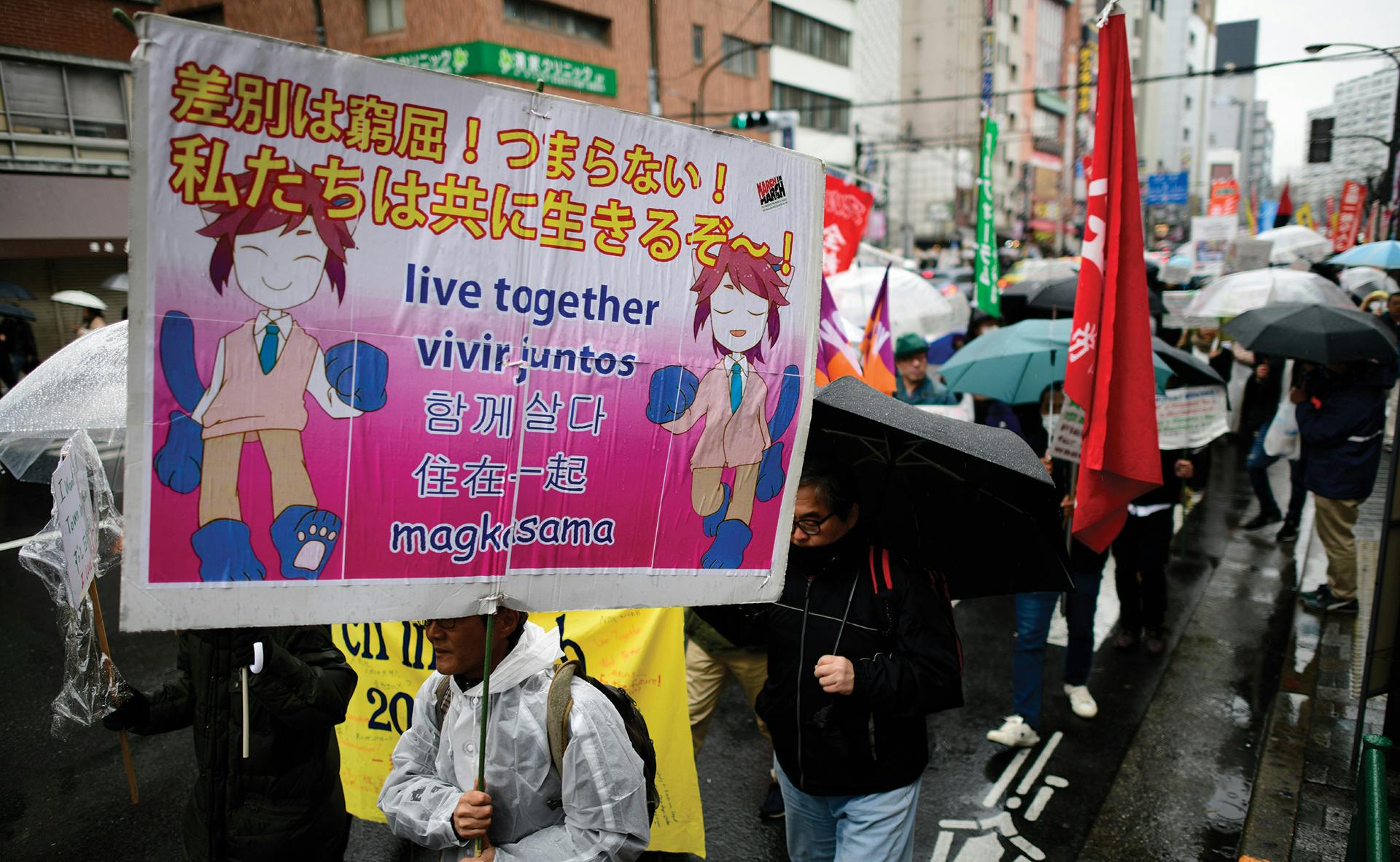In December, the Japanese legislative body, the National Diet, passed a controversial new guest worker visa program. Pushed through with little debate by Prime Minister Shinzo Abe and his center-right Liberal Democratic Party, the program would welcome 345,000 low-skilled workers into Japan over the next five years—something that the archipelago nation, long known for its resistance to immigration, has never seen before.
“This is the new reality of Japan,” says David Green, an associate professor at Meijo University in Nagoya, Japan. “Going forward, Japan has little choice to open itself up more to immigration, especially unskilled labor . . . in order to survive and remain competitive.”
As countries including the United States, Britain, Italy, and Germany look to reduce immigration due to growing social concerns that have led to the rise of right-wing politicians, Japan’s moves, under a government some political scientists consider among the most conservative since World War II, show a possible future when demographics force even the most historically immigration-averse nations to open their borders.
The origins of Japan’s slow shift towards being more accepting of migrants can be connected to a trend that reached a historic apex in 2015. That year, in a modern first for a country not in war, Japan’s population shrank, the results of decades of falling birthrates and very little immigration. The country has lost a million residents over five years, and the trend lines are worrying. Without serious intervention or an influx of migrants, Japan’s population is projected to shrink by almost 30 million by 2055.
A shrinking population is only part of the problem. Those 89 million remaining Japanese residents in 2055 will have an average age of 53, making it the oldest society in history. Upwards of 40 percent will be above retirement age, meaning that the pension system—which depends on workers paying into it—will be stretched very thin.
“Japan is the first country to go through this in the entirely of humanity,” says Jennifer Dabbs Sciubba, a professor of international studies and demographic change expert at Rhodes College in Tennessee.
The distant problem is worrying, but for Abe, the goal might be address a more present challenge. Japan is already facing a labor shortage. The unemployment rate is at a minuscule 2.4 percent—for comparison, the U.S. is at 4 percent, and that’s considered full employment, while France is at 8.8 percent. A rate of 2.4 percent means that there are more jobs than workers; a rate that low is generally understood to mostly just represent people transitioning between jobs. In fact, Bloomberg reported that vacancies outnumbered applicants by more than 3 to 1 in some industries.
While the guest worker program is unprecedented, Japan has permitted immigration in the past. During its colonial period (1910–1945), many subjects from Korea, Taiwan, and China emigrated to Japan, and today their descendants find themselves in a strange position of being Japanese in identity but still lacking citizenship. In the 1980s, Japan created the Nikkei-jin visa, specifically aimed at ethnic Japanese living abroad, who, it was assumed, would be better able to integrate into society. Over the past two decades, more than 300,000 people, mainly from Brazil and Peru, migrated to Japan under this program. Add it all together, though, and it still means that until recently, less than one percent of the population was made up of foreign-born workers.
“Japan has always made this conscious choice to limit immigration for national identity,” says Sciubba.
After the 2008 financial crisis, many of the jobs for these migrants vanished, and Japan created a new program to encourage them to return to South America. They were offered one-time payments to return home in exchange for losing their visa. Part of this reflected a realization that shared ethnicity did not necessarily mean easy assimilation.
“The expectations were that co-ethnic Japanese from Peru and Brazil would adapt to life in Japan quickly,” says Erin Aeran Chung, professor of East Asian politics at John Hopkins University and author of a book on migration into Japan. “However, Japan soon found most of the co-ethnic Japanese did not naturally assimilate, continued to suffer from low rates of Japanese literacy, faced discrimination in workplace, and were just as foreign as any other worker.”
So what’s different about this program? The first significant change is that it focuses on unskilled labor, a novelty in Japanese policy. It also expressively limits the path towards permanent residency for those who enter on this visa. The wording of the recent law reflects this delicate political balance, avoiding the words “immigrant” or “immigration.”
“The Abe administration has made clear that the proposed revision is not a full-fledged immigration policy,” says Chung. “For example, Japan will periodically compel them to return to their home countries, so they can’t meet residency requirements for residency or naturalization.”
The law's is modeled on guest worker programs in Europe in the post-war period, and therein also lies a lesson. Germany welcomed about 700,000 migrant workers, primarily from Turkey, in the 1960s and early 1970s, and the program was, like Japan’s, meant to only allow workers to remain for two years. In the end, many of those migrants stayed in Germany and became permanent residents. Today, there are over 2 million residents of Turkish descent living in Germany.
“There are concerns . . . whether Abe can have his cake and eat it too—trying to import workers, but prevent settlement,” says Chung. “In other advanced democracies, guest workers became permanent residents and members of the population. Why should Japan should expect that this guest worker program would succeed [when similar programs] have failed elsewhere?”
But maybe that will not matter. Spend any time in Japan, and the scale of the demographic challenge becomes clear. It’s a daily topic in the media, among academia, and in the Diet. Economists cite it as a major reason for the country’s long-standing economic stagnation. Travel outside of the major metropolitan areas of Tokyo and Osaka, where the population is still growing due to migration from rural areas, and you’ll find villages full of the elderly, or others where increasing numbers of homes are empty due to the passing of their owners. This glaring reality of the crisis is shifting attitudes about migration.
“Polls of voters . . . have generally shown that they are in favor, or neutral, about letting in more foreign workers,” says Chung, citing a Yomiuri Shinbun poll that showed 50 percent of voters in favor of letting in more unskilled workers, and 40 percent in favor of recognizing immigration. “So there is a shift in regards to social acceptance of migrants.”
Another sign of this is in the public response to the guest worker program. Abe’s bill saw pushback, but it was equally, if not more so, from the left than the anti-immigrant right. Labor unions expressed concern that migrant workers would suppress wages, while other were worried about exploitation—something seen with existing trainee visa programs. Ultimately, this might be a trial balloon that, if successful, could allow for more migrant workers in the future. “The government has realized that immigration has to be increased, but since it’s not popular, these are the initial steps toward it,” says Green.
One thing that will likely not change is Japan’s resistance to accepting refugees. In 2017, only 20 out of more than of 20,000 applications were granted asylum—by far the lowest of any OECD country. To its credit, Japan does try to make up for this being one of the largest funders to the United Nations Refugee Agency and other humanitarian organizations in places like South Sudan, Syria, and the Palestinian territories. But in a country whose Diet still can't say the word “immigrant” in its immigration policy, "refugee" is even more perilous.
In the end, 345,000 guest workers over five years is a large number in the context of Japan, but it pales in comparison to migration figures in other major advanced economies. Germany accepted more than a million refugees in 2015 alone, and Canada aims to accept 350,000 immigrants a year by 2021—despite having only one-fifth the population of Japan. But from a social perspective, the move is significant, though mostly symbolic.
“My inclination is that this is not going to go as well as planned, and within five or ten years, if not sooner, the government is going to open itself further to some other similar program, but a bit more general or liberal,” says Green. With so many restrictions—including a Japanese language requirement—he’s skeptical that 345,000 guest workers will even arrive. And even if they do, it won’t address the 1.2 million worker shortage that the government estimates.
“Japan has no choice except to make some drastic changes,” says Green. “I think Japanese society in 20 or 30 years is going to look much different than it does now . . . quite a bit more multicultural, and with a lot more immigrants. But the question remains on how to get to that point, and how it's going to work.”






![true [X]](https://images.prismic.io/overtureglobalio/d20d19f0ac141059ec92c667f6cddf6ca09e2c1a_truex-logo2x.png?auto=compress,format)





